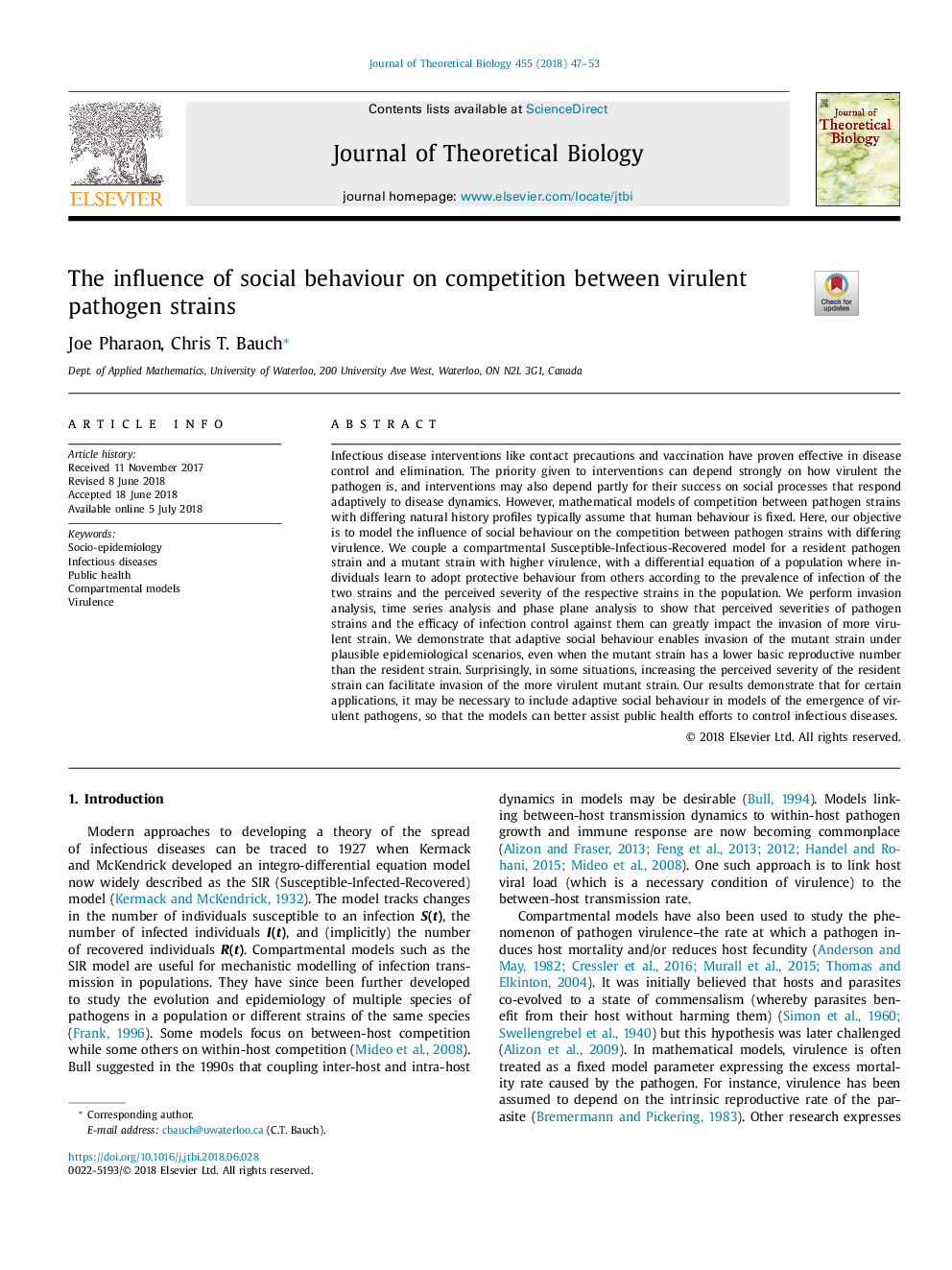| کد مقاله | کد نشریه | سال انتشار | مقاله انگلیسی | نسخه تمام متن |
|---|---|---|---|---|
| 8876474 | 1623755 | 2018 | 7 صفحه PDF | دانلود رایگان |
عنوان انگلیسی مقاله ISI
The influence of social behaviour on competition between virulent pathogen strains
ترجمه فارسی عنوان
تأثیر رفتار اجتماعی بر رقابت بین گونه های پاتوژن
دانلود مقاله + سفارش ترجمه
دانلود مقاله ISI انگلیسی
رایگان برای ایرانیان
کلمات کلیدی
اجتماعی و اپیدمیولوژی، بیماری های عفونی، سلامت عمومی، مدل های مجتمع، ویروسی شدن،
ترجمه چکیده
مداخلات بیماری عفونی مانند اقدامات احتیاطی و واکسیناسیون در کنترل و پیشگیری از بیماری موثر است. اولویت داده شده به مداخلات می تواند به شدت به این بستگی دارد که چگونه ویروس پاتوژن است، و مداخلات نیز ممکن است بخشی از موفقیت آنها در فرآیندهای اجتماعی است که سازگار با پویایی بیماری هستند. با این حال، مدل های ریاضی رقابت بین سویه های پاتوژن با پروفایل های مختلف تاریخ طبیعی فرض می کنند که رفتار انسان ثابت شده است. در اینجا هدف ما این است که تاثیر رفتار اجتماعی بر روی رقابت بین گونه های پاتوژن با ویروسی متفاوت را مدل کنیم. ما یک مدل مجزا حساس به عفونت مجاز برای یک پوزیشن پاتوژن ساکن و یک سوپروتئین با ویروسی بالایی با یک معادله دیفرانسیل از یک جمعیت که در آن افراد یاد می گیرند رفتارهای محافظتی دیگران را بر اساس شیوع عفونت دو سویه و شدت درک شده از سویه های مربوطه در جمعیت. ما تجزیه و تحلیل تهاجم، تجزیه و تحلیل سری زمانی و تجزیه و تحلیل فاکتور را انجام می دهیم تا نشان دهد که شدت درک شده سویه های پاتوژن و اثربخشی کنترل عفونت در برابر آنها می توانند تا حد زیادی بر نفوذ سویه های ویروسی بیشتر تاثیر بگذارد. ما نشان می دهیم که رفتار انطباق اجتماعی، حمله به سوند جهش را در سناریوهای اپیدمیولوژیک قابل اعتماد می گیرد، حتی زمانی که سویه جهش یافته دارای تعداد کمتری از عدد پروتئین است. به طرز شگفتآورى، در بعضی موارد، افزایش شدت درک شده سویه ساکن میتواند نفوذ به سویه جهش یافتهتری را تسهیل کند. نتایج ما نشان می دهد که برای برنامه های خاص، ممکن است لازم باشد که رفتار اجتماعی سازگار را در مدل های ظهور پاتوژن های ویروسی موجود در نظر بگیریم، به طوری که این مدل ها می توانند به بهتر شدن تلاش های بهداشت عمومی برای کنترل بیماری های عفونی کمک کنند.
موضوعات مرتبط
علوم زیستی و بیوفناوری
علوم کشاورزی و بیولوژیک
علوم کشاورزی و بیولوژیک (عمومی)
چکیده انگلیسی
Infectious disease interventions like contact precautions and vaccination have proven effective in disease control and elimination. The priority given to interventions can depend strongly on how virulent the pathogen is, and interventions may also depend partly for their success on social processes that respond adaptively to disease dynamics. However, mathematical models of competition between pathogen strains with differing natural history profiles typically assume that human behaviour is fixed. Here, our objective is to model the influence of social behaviour on the competition between pathogen strains with differing virulence. We couple a compartmental Susceptible-Infectious-Recovered model for a resident pathogen strain and a mutant strain with higher virulence, with a differential equation of a population where individuals learn to adopt protective behaviour from others according to the prevalence of infection of the two strains and the perceived severity of the respective strains in the population. We perform invasion analysis, time series analysis and phase plane analysis to show that perceived severities of pathogen strains and the efficacy of infection control against them can greatly impact the invasion of more virulent strain. We demonstrate that adaptive social behaviour enables invasion of the mutant strain under plausible epidemiological scenarios, even when the mutant strain has a lower basic reproductive number than the resident strain. Surprisingly, in some situations, increasing the perceived severity of the resident strain can facilitate invasion of the more virulent mutant strain. Our results demonstrate that for certain applications, it may be necessary to include adaptive social behaviour in models of the emergence of virulent pathogens, so that the models can better assist public health efforts to control infectious diseases.
ناشر
Database: Elsevier - ScienceDirect (ساینس دایرکت)
Journal: Journal of Theoretical Biology - Volume 455, 14 October 2018, Pages 47-53
Journal: Journal of Theoretical Biology - Volume 455, 14 October 2018, Pages 47-53
نویسندگان
Joe Pharaon, Chris T. Bauch,
